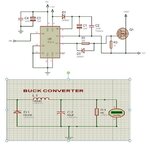assu
Junior Member level 3
Last edited by a moderator:
Follow along with the video below to see how to install our site as a web app on your home screen.
Note: This feature may not be available in some browsers.
HiI m using the following ckt with my buck converter the issue is the ir2110
Hi
You sure you have used IR2110 ? you schematic says it is IR2101 isn't it ? if you used IR2110 i must say that can't operate as a bootstrap drive in the position which you've used . it must have L side too . but if it's IR2101 everything is different .
So what you have done ?
Best Wishes
Goldsmith

Do you have current probes to check VxI transition power or monitor with 100mV current shunt?
1st case with diode improves fall time and improves Mosfet transition losses at the expense of higher driver current losses.
Is boost voltage in range?
Well i am not using 100% duty cycle, i m driving it on 39% duty cycle.Hi,
Added:
To improve on this you may use the LO pin to drive the HS pin to GND. Maybe you need extra circuit on driving LI synchronous to HI. When HO is low, then LO needs to be low too. Avoit crossconducting..
Good luck
Klaus
Oh, the drain of the FET is on the same line, so switching of the load causes extra voltage spikes.
Now i recommend to use a 10 Ohms series resistor to V+, a ceramic 100n and a 47U tanatalum.
Also i recommend a LOW ESR electrolytic capacitor at drain of FET, at least 100uF (up to 1000uF), paralleled a 100nF ceramic.
An overvoltage protection on V+ with an external 20V zener may also improve functionality.
Hope this helps
Klaus

Yes, failing to charge the bootstrap capacitor is a possible problem of the asynchronous buck converter. But it would cause switching drop-out, not heating of the driver.You have to ensure, that the VS pin is low ( at least for some us) to charge the bootstrap capacitor.
Either the load ensures that, or you have to do this. It is possible with the low side driver.
Salam to all
I m using the following ckt with my buck converter the issue is the ir2110 heats up after 3 seconds...i have tried two ckts but it doesnt matter it still heats up .
Can anyone tell me what is the issue?
Note: 15Vdc is from solar pannel. N-channel mosfet is used for high side.
View attachment 106456
View attachment 106457
okay thanks for the suggestions, ill check the ckt practically and post the result.Hi,
Your schematic:
R2 should be on the right side of C5 in direction to supply input..
C1 and C5 upper connection must be directely connected to V+ of driver.
the lower connection of C6 and C7 must be connected to GND.
Drain of Q3 to the upper side of C6, C7 und supply input.
R6 is not good. it draws a steady current out of the bootstrap capacitor, when high.
+++++++
Not wrong... But D5 is not needed. instead you can lower R5. This sppeds up switching. But increases noise and ringing, especially when layout is not optimal..
Klaus